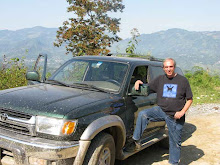Crisis in Mexico’s indigenous communities-
Who are the Cholos , no it is not another indigenous group, well not a historical one, they are young men and women who have left the village to work either in Mexico City or the US and return dressed as gang members who resent or hate their culture. They influence the younger kids by bad example. Recently in some Totonacan towns in the Sierra Norte of Mexico I saw a group of 20, spiked hair dressed in black with pierce tongues and noses, they seem like they landed there from another planet. A village elder said to me that they come home and act badly and “se sienten hombre” which means they feel like men.
But why? It is not enough to say that these young men and women HAD to leave their villages to find work. Did they really have to leave? The answer lay in the statistics from many municipalities in 2005. They are alarming in one typical municipality, 280 children born 28 persons die, this is a receipt for immigration or civil war and for sure poverty. What is Mexico going to do with all these young people? America get ready for massive immigration from Mexico.
Among the older generations there is desperation because they are unable to get the kids to work in the fields. This is not simple a economic activity, the world revolves around the earth and the cycles of agriculture, the weather and religious festivals. It is all part of a greater view of the world. Many “religious” festivals are based on traditional agricultural ceremonies. I recently witnessed the 12 Prayers ceremony in a Totonacan village in Veracruz. The women prayer for 12 days that nothing would happen to them ( not for bigger houses or a large screen TV) during the year and them placed all the prayers ( in the form of eggs) into a hole in the ground along with offerings. Is the land important you bet it is?
The land in many indigenous villages is very rugged and there is no way to plant except do every thing by hand. Even if the terrain was flat the prices paid for agricultural commodities does work to accumulate wealth. In the past subsistence farming was enough, grow what you need and if there is some left, over trade it for something that you need. This worked for thousands of years. Suddenly there are more mouths than the land can support. Not all that is learned is bad but the net result is that these people who were satisfied with a way of life that was based on agricultural cycles and inter relationships in the village has been gradually eroded by materialism and economic necessity based on over population.
Let’s add another nail in the coffin of agricultural indigenous Mexico, NAFTA, in 2008 the Indians will have to compete with American and Canadian commercial farming. The tariff free entry of grains will crush the prices of corn. Corn is the traditional food in the communities, Mexicans are the people of corn. So the peasant the is working a parcel of land on a steep hill side with a hoe is now being asked to compete with 40 square miles of land cultivated with genetically modified seeds and agricultural machinery that cost more than an entire village makes in a year.
In the next years we are going to see increased immigration to the cities, continued population growth, the gradual and certain erosion of indigenous values and agricultural way of life. There are efforts to replace agriculture with other forms of livelihoods these are going to take time and do not help protect indigenous culture. What does a trout farm have to do with the cycle that indigenous people live by? Nothing…
Sunday, December 30, 2007
Labels:
indian wisdom,
indigenous textiles,
mexico,
Nahua,
Puebla,
Sierra Norte de Puebla,
Totonacan
Subscribe to:
Post Comments (Atom)


1 comment:
I am sure that this is not a recent post, but I felt I needed to say how right you are. I am a teacher of English as a Second Language, and I see the other side of it: disenfranchised youth coming to the United States. Often, they forget the good of their culture, and only see the greedy part of ours. I am so tired of my students succumbing to the lure of gangs, and it disheartens me even more when I return to Mexico to see the same ugly gang graffiti we have up here. I don't know what the solution is - but I admire you so much for preserving part of the vanishing culture of Mexico.
Post a Comment